Top/Tactile sensor
Tactile sensorLast-modified: 2012-08-09 (木) 15:00:00
Net-Structure Tactile SensorA tactile sensor is developed with the aim of covering a robot’s entire structure, while reducing wiring requirement and ensuring high-speed response. The sensor detects the center point of load distribution on 2-D surfaces as well as the overall load. There are only four signal wires from the sensor. The sensor response time is nearly constant (within 1 ms) regardless of the number of detection elements, their placements or sensor areas. The structure of the sensor is shown below. 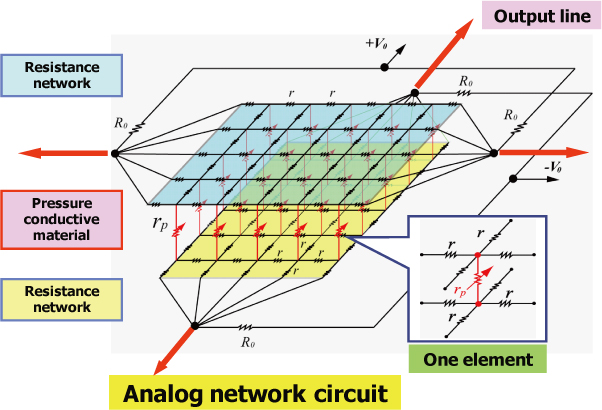
The video shows the prototype of a sensor. The prototype sensor used a pressure-conductive rubber as the detector element. The elements were arranged in a 3x3 grid. A Prototype of tactile element arranded on 3×3 grid. Each element can be cut from the sheet and may be attachable on any surface. The detector elements consist of pressure-conductive rubber laid down on top of electrodes (spiral shape). 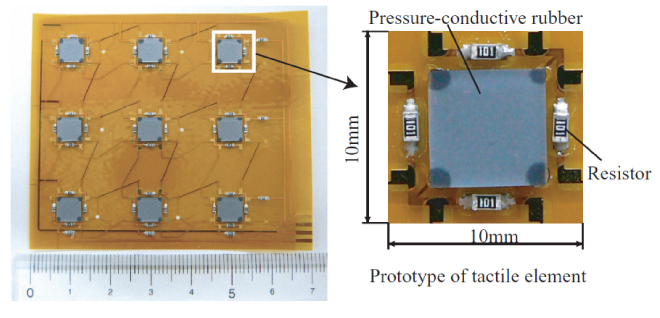 The tactile sensor mounted on a manipulator. When load is added to the sensor, the sensor detects the contact position and load and a robot arm will move in the direction of applied force. Tactile sensor(Film type)The sensor detects the center position of a distributed load on the sensor and the total load of the distribution. The sensor is sheet-like in form, lightweight (0.2g/cm2), offers a high-speed response (within 1 ms), and needs a little wiring (four wires). The structure of the sensor is shown below. This sensor has a three-layer structure. Upper and lower layers are made of electrical conductive material coated film, and middle is Pressure-conductive rubber. Pressure-conductive rubber changes its resistance in the thickness direction according to the distributed pressure. The black areasin Fig. indicate metal electrodes. #ref(): File not found: "CoPonfinger.jpg" at page "Tactile sensor" The following video shows how the sensor works. Next figures shows the CoP sensor is attached on the hand. Since there is few wiring, wiringis not interfered with attaching the sensors to a multi-finger hand. 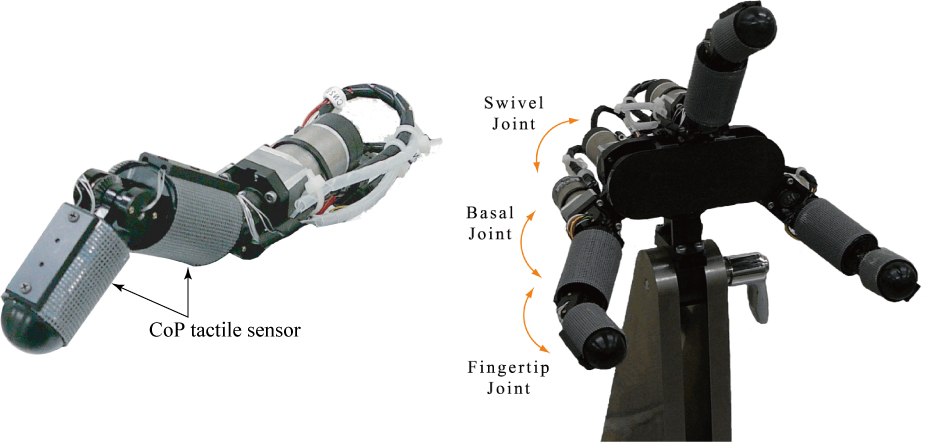
Since this sensor can detect the contact position and load of a subject within 1ms, high-speed handling is possible as shown in video.
The tactie sensors are mounted on the fingers. When the sensor detects contact , grasping moton stops. When a glass is pushed from the bottom, the grasping force of a hand will be strengthened to prevent sliding. Next video shows Stanford JPL hand with CoP sensor handling a piece of rod. The white part is sensor. The oscilloscope in the back shows the locus of a contact position on the fingertip. The horizontal axis shows the direction of the finger circumference, and a vertical axis shows the direction of the finger lengthwise. (Tactile sensor was mounted on the JPL hand in 1986. I am greatly thankful to Professor Ronald S. Fearing who helped the experiment.) Tactile sensor(Wire-stitch type)In this study, we adopted a single-layer composite structure by stitching electrodes (wires) into pressure-conductive rubber. We intended to keep the thin flexible property while improving durability with regard to the tangential force and deformation. 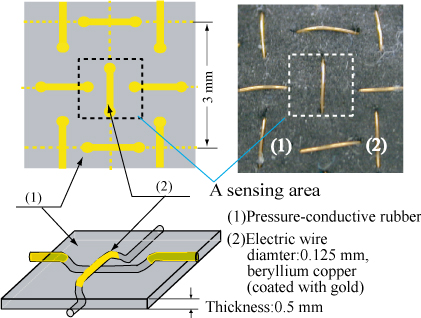 The sensing element was configured at the intersection of the row and column of electrodes. The wire was stitched at 3-mm intervals in the horizontal and vertical directions. Figure shows a robot hand with the developed tactile sensors. The tactile sensor is attached to four fingers, and covered with a silicon rubber film. 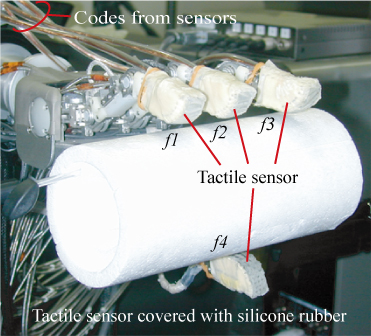 Views of the fingertip. Tactile sensor array: 3x16 with 3 mm pitch.The size of fingertip: 44 mm x 12 mm. 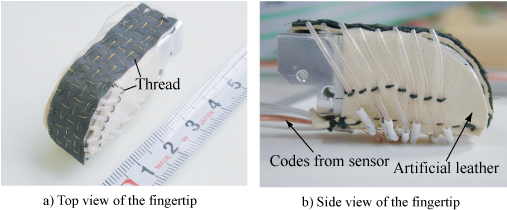 we used the zero potential method to prevente cross talk currents. Setting all drive lines (row electrodes) which do not involve the measuring point at zero voltage, and also, setting all outputlines (column electrodes) at zero voltage. 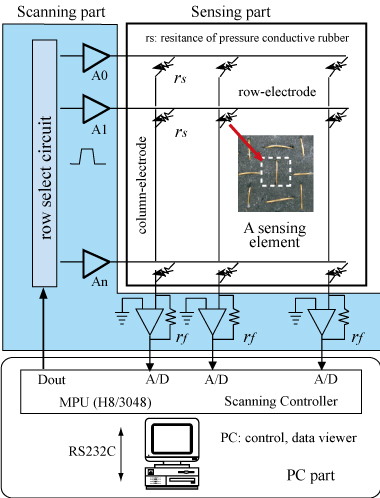 Figure shows the distribution of grasping pressure when a sphere, column, and a human arm, 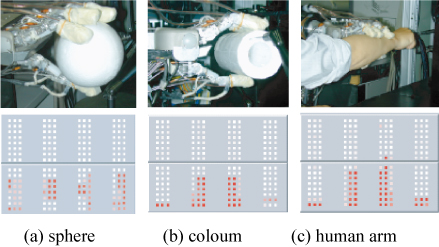 Sensor GloveVideo shows a Sensor Glove for measurement of grasping force distribution. This sensor has pairs of flexible copper wires (0.125 mm) plated with gold in stripes and sewn on a pressure-sensitive conductive rubber sheet(0.5 mm thick) at intervals of 8.5 mm vertically and horizontally. The pressure sensitive points numbers 103, the distribution of which is 4 at each fmgertip, 3 in each interarticular region, 10 in the thenar prominence, and 46 in the palm.
Tactile sensor(Video signal output type)A high resolution and sheetlike form imaging tactile sensor with video signal output has been developed. The sensor has a 64 x 64 array of sensing elements on a flexible PC board within 1mm spatial resolution. Since the sensor outputs pressure distribution as a video signal, real time tactile image can be observed by using TV monitor. Moreover the same hardware and software as a vision system can be used for measured data handling, tactile image processing and recording become very simple. 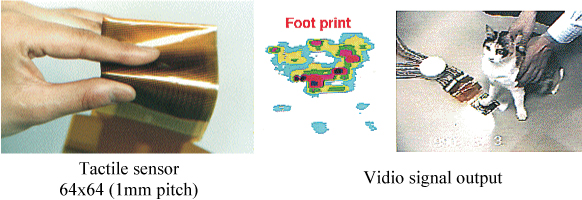
Active touch tactile sensor(Spatial filter type)A sensor system that measures the surface pattern of objects by using a spatial filtering tactile sensor is presented. The sensor has a bandpass spatial filtering function and changes its center of spatial frequency with the tactile motion. The idea of this method is based on the nervous system in a human finger. This sensor system is characterized by robot measurement for nonuniform contact states, adaptability for a wide spatial frequency range in the surface pattern of objects, and high spatial resolution. 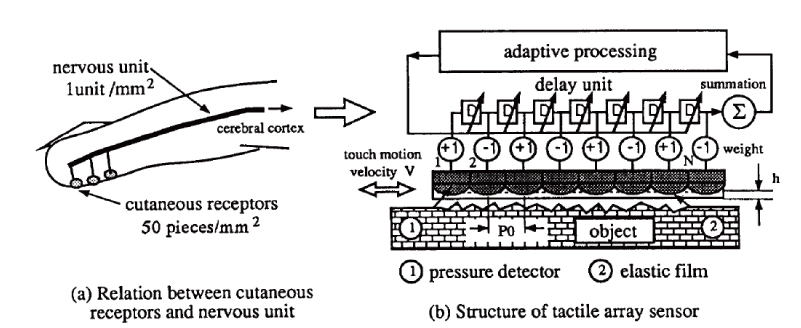
|
![[Shimojo Laboratory] [PukiWiki]](image/comm.jpg)